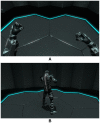From Robot to Virtual Doppelganger: Impact of Visual Fidelity of Avatars Controlled in Third-Person Perspective on Embodiment and Behavior in Immersive Virtual Environments
- PMID: 33501025
- PMCID: PMC7805911
- DOI: 10.3389/frobt.2019.00008
From Robot to Virtual Doppelganger: Impact of Visual Fidelity of Avatars Controlled in Third-Person Perspective on Embodiment and Behavior in Immersive Virtual Environments
Abstract
This study presents the second phase of a series of experiments investigating the impact of avatar visual fidelity on the sense of embodiment and users' behavior in immersive virtual environments. Our main focus concerns the similarity between users and avatars, a factor known as truthfulness. Our experiment requires the participants to control three avatars using a third-person perspective: a robot, a suit and their virtual doppelganger (virtual representation of the self). In order to analyze users' reactions and strategies, each task of the scenario of the virtual reality application can potentially affect the integrity of their characters. Our results revealed that ownership, one of the three factors of the sense of embodiment, is higher for the participants controlling their self-representation than with abstract representations. Furthermore, avatar visual fidelity seems to affect users' subjective experience, half of the panel reported having different behavior depending on the controlled character. Abstract representations allow the users to adopt more risky behaviors, while self-representations maintain a connection with the real world and encourage users to preserve the integrity of their avatar.
Keywords: Proteus effect; avatar; doppelganger; embodiment; virtual reality.
Copyright © 2019 Gorisse, Christmann, Houzangbe and Richir.
Figures








Similar articles
-
Impact of Personalized Avatars and Motion Synchrony on Embodiment and Users' Subjective Experience: Empirical Study.JMIR Serious Games. 2022 Nov 8;10(4):e40119. doi: 10.2196/40119. JMIR Serious Games. 2022. PMID: 36346658 Free PMC article.
-
Exploring the Relationship Between Attribute Discrepancy and Avatar Embodiment in Immersive Social Virtual Reality.Cyberpsychol Behav Soc Netw. 2023 Oct 18. doi: 10.1089/cyber.2023.0210. Online ahead of print. Cyberpsychol Behav Soc Netw. 2023. PMID: 37851990
-
Effects of an Avatar Control on VR Embodiment.Bioengineering (Basel). 2025 Jan 3;12(1):32. doi: 10.3390/bioengineering12010032. Bioengineering (Basel). 2025. PMID: 39851306 Free PMC article.
-
Avatar Embodiment. Towards a Standardized Questionnaire.Front Robot AI. 2018 Jun 22;5:74. doi: 10.3389/frobt.2018.00074. eCollection 2018. Front Robot AI. 2018. PMID: 33500953 Free PMC article. Review.
-
Boosting Creativity through Users' Avatars and Contexts in Virtual Environments-A Systematic Review of Recent Research.J Intell. 2023 Jul 17;11(7):144. doi: 10.3390/jintelligence11070144. J Intell. 2023. PMID: 37504787 Free PMC article. Review.
Cited by
-
The Open Virtual Mirror Framework for enfacement illusions : Enhancing the sense of agency with avatars that imitate facial expressions.Behav Res Methods. 2023 Feb;55(2):867-882. doi: 10.3758/s13428-021-01761-9. Epub 2022 May 2. Behav Res Methods. 2023. PMID: 35501531 Free PMC article.
-
Immersive virtual reality health games: a narrative review of game design.J Neuroeng Rehabil. 2021 Feb 11;18(1):31. doi: 10.1186/s12984-020-00801-3. J Neuroeng Rehabil. 2021. PMID: 33573684 Free PMC article. Review.
-
The manipulation of top-down interpretation as one's symptomatic body reduces the sense of body ownership.Front Psychol. 2024 Dec 23;15:1399218. doi: 10.3389/fpsyg.2024.1399218. eCollection 2024. Front Psychol. 2024. PMID: 39764081 Free PMC article.
-
Measuring recognition of body changes over time: A human-computer interaction tool using dynamic morphing and body ownership illusion.PLoS One. 2020 Sep 18;15(9):e0239322. doi: 10.1371/journal.pone.0239322. eCollection 2020. PLoS One. 2020. PMID: 32946504 Free PMC article.
-
Greater interpersonal distance in adults with autism.Autism Res. 2023 Oct;16(10):2002-2007. doi: 10.1002/aur.3013. Epub 2023 Sep 1. Autism Res. 2023. PMID: 37658641 Free PMC article.
References
-
- Argelaguet F., Hoyet L., Trico M., Lecuyer A. (2016). The role of interaction in virtual embodiment: effects of the virtual hand representation, in 2016 IEEE Virtual Reality (VR) (Greenville, SC: ), 3–10.
-
- Aymerich-Franch L., Bailenson J. (2014). The use of doppelgangers in virtual reality to treat public speaking anxiety: a gender comparison, in Proceedings of the International Society for Presence Research Annual Conference (Vienna: Citeseer; ), 173–186.
-
- Bailenson J., Beall A., Blascovich J., Raimundo M., Weisbuch M. (2001). Intelligent agents who wear your face: users' reactions to the virtual self, in International Workshop on Intelligent Virtual Agents, Vol. 2190 (Berlin; Heidelberg: Springer; ), 86–99.
-
- Bailenson J. N., Blascovich J., Guadagno R. E. (2008). Self-representations in immersive virtual environments. J. Appl. Soc. Psychol. 38, 2673–2690. 10.1111/j.1559-1816.2008.00409.x - DOI
LinkOut - more resources
Full Text Sources

